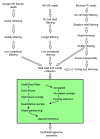De novo genome sequence assembly of a filamentous fungus using Sanger, 454 and Illumina sequence data
- PMID: 19747388
- PMCID: PMC2768983
- DOI: 10.1186/gb-2009-10-9-r94
De novo genome sequence assembly of a filamentous fungus using Sanger, 454 and Illumina sequence data
Abstract
Sequencing-by-synthesis technologies can reduce the cost of generating de novo genome assemblies. We report a method for assembling draft genome sequences of eukaryotic organisms that integrates sequence information from different sources, and demonstrate its effectiveness by assembling an approximately 32.5 Mb draft genome sequence for the forest pathogen Grosmannia clavigera, an ascomycete fungus. We also developed a method for assessing draft assemblies using Illumina paired end read data and demonstrate how we are using it to guide future sequence finishing. Our results demonstrate that eukaryotic genome sequences can be accurately assembled by combining Illumina, 454 and Sanger sequence data.
Figures




References
Publication types
MeSH terms
Substances
LinkOut - more resources
Full Text Sources
Other Literature Sources
Molecular Biology Databases
Miscellaneous

